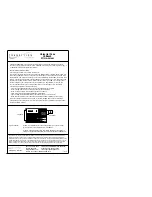
4200 Series Transmitters
Instruction Manual
Form 5596
November 2006
22
NOTES:
RELAYS K1 AND K2 ARE SHOWN IN THE DE-ENERGIZED POSITION (TRIPPED POSITION).
1
29A6206-D / DOC
1
1
Figure 10. Schematic Diagram for the Field Printed Wiring Board
circuit input. Each of the position switch circuit
outputs is connected to a relay on the field circuit
printed wiring board, and depending on the
potentiometer position, the relays are energized or
de-energized.
Transmitter Circuit
At all times, the current flow into the transmitter
equals the current flow out of the transmitter. The
current flowing into the transmitter divides between a
regulator circuit and transistor Q1.The regulator
circuit establishes two voltages one of which is
(VREF). This voltage is applied across the input
potentiometer. The other voltage, (VREG) powers
the Op Amps.
On units with position switches, the transmitter
voltage regulator, 4 to 20 mA signal, and relay coil
currents flow in the wire between the power supply
(+) terminal and the (+) terminal on TB3. The
transmitter voltage regulator, switching, and relay
coil currents are returned to the power supply
common from the (R) terminal on TB3. The 4 to 20
mA output signal flows between the (
−
) terminal on
TB3 and the power supply common. This prevents
the relay coil switching currents from appearing on
the 4 to 20 mA output.
Position Switch Circuit
A regulated voltage is setup to power the position
switch circuit. The position switch circuit senses the
position of the potentiometer and triggers the
appropriate position switch relay (K1 or K2, figure
10) when travel reaches the trip points established
by the adjustments. The Type 4215 transmitter uses
dual potentiometers which allows individual
potentiometers for the transmitter circuit and the
position switch circuit.
















































